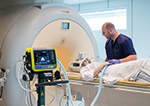Ventilation therapy during MRI procedures also for neonates
With the intelligent Hamilton‐ MR1 ventilator, patients can be moved from the ICU to the MRI suite and back without having to change anything about the ventilation, even when they areon an advanced mode. This diminishes the risks for lung de‐recruitment and a patient setback, which would keep patients in the hospital longer and make their stay more uncomfortable. The new Neonatal option now also optimizes the Hamilton‐ MR1 for MR‐compatible neonatal ventilation. With tidal volumes as low as 2 ml, safe and lung‐protective ventilation of even the most fragile patients is guaranteed. The IntelliTrig intelligent leak compensation function automatically adjusts the inspiratory and expiratory trigger sensitivity to potential leaks. This enables optimal synchronization with the neonate’s breathing pattern. The small and rugged housing, an integrated high‐performance turbine and powerful internal batteries make the Hamilton‐MR1 ideal for patient transport and easy to handle for the caregiver. The wide range of modern and classic ventilation modes guarantees that before, during, and aft er the MRI procedure, all patients from neonates to adults receive the same high level of ventilation care as at the bedside. The Hamilton‐MR1 is the first ventilator that can be used at a magnetic field strength of 50 mT, equivalent to 1 m distance for a 3T static magnetic field scanner, without creating any MR image artifacts. Positioning a medical device too close to the MRI scanner can have fatal consequences. For maximum safety, the ventilator continuously monitors the magnetic field with TeslaSpy, an integrated gaussmeter, and gives an audible and visual signal if it is getting too close.



